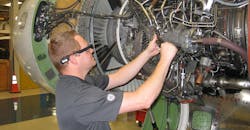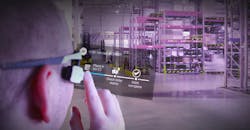Here at NED, we're big on industrial wearables, as we believe they tether industrial workers to technology rocketing forward so fast, we couldn't otherwise keep up. The space is filled with a lot of hype and speculation, so to keep ourselves grounded, we often turn to the fine folks at Upskill. The software platform Skylight the Washington D.C. –based company makes connect enterprises with the hardware manufacturers, and in their research, they are some of the first to know what industry needs, and what the current gamut of smartglasses can provide.
In their new webinar, What's Next for Enterprise AR in 2018, (Jan. 18th at 2 p.m ET/ 11 a.m. PT) Upskill is offering anyone who registers a chance to glean those same insights and better for big changes this year. Hosted by CEO and co-founder Brian Ballard and Jay Kim, chief strategy officer, this webinar is meant to cut through all the bull and the buzz the tech media is so found of shoveling your way (sorry about that).
It's a great time to start fine-tuning your wearable plan, because if you don't, you might want to start developing a new career plan. Wearables are going to be a vital tool in several factory applications, so hang on or hop off.
On just the first use, GE technicians who wore smartglasses with Skylight saw a 34% increase in productivity.
“In just three to five years, I can’t imagine a person on the plant floor that doesn’t have a wearable device to help them do the job,” says Paul Boris, VP of Manufacturing Industries at GE.
We recently spoke with Kim while he was checking out the latest tech at CES 2018 about what to expect from the webinar.
Look for brand new cases on a regular basis, from training, to work instructions to how people connect with IoT devices.
And in 2018, smaller, more agile companies will follow suit and may do it better.
"Smaller companies have less red tape," Kim says, which could slow down adoption at industry behemoths. "Capital equipment and complicated workflows need to be turned over to adapt new technology at scale."
The limiting factor for these smaller businesses is lack of infrastructure, and Kim notes that new plants and factories that work AR into their design up front will have a much easier time making the change.
Service and logistics will go all in on AR:
The small sample size of use cases weighed against a fairly large investment will make the typical factory floor a difficult place for significant AR/wearable to take over in 2018, Kim says.
More likely, he says, the area to watch is in the stock room, parts warehouses, and distribution centers.
In picking, sorting, and packing jobs, smartglasses paired with a Bluetooth-enabled ring scanner act as a know-it-all sidekick, filling your HUD with additional info to speed up your tasks. At a GE Healthcare facility in South Carolina, smartglasses led the worker to the correct bins and quickly guided them through the correct order of parts to pick, leading to a 46% improvement in order completion time.
"Using smartglasses allows people to ramp up faster so they hit max efficiency," Kim says. That fundamentally changes how people interface with work."
So that means you shouldn't rule out at least some pretty game-changing applications in manufacturing, from implementing line configurations to part changes.
If you are expecting the smartglasses' camera to automatically detect what part you need on a towering stack of shelving, you may still have to wait. According to Kim, that tech has not reached maturation yet.
Speech will be the loudest voice in enterprise AR:
"The most damning thing about gesture control is it does tie up your hands,which is a big deal in industrial applications," Kim says.
While there is still a place for them, he says the primary driver will be voice guidance. You say a command, such as "Show me work instructions," and they pop up on your monocular display.
We demoed them with the RealWear HMT-1, and can attest to them being deployable now. They respond flawlessly to voice commands, even in 96 dB environments.
For more predictions from Upskill, register for the webinar here: https://upskill.io/landing/2018-augmented-reality-predictions-webinar/













